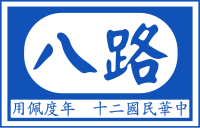Eighth Route Army
This article needs additional citations for verification. (January 2017) |
| Eighth Route Army | |
|---|---|
 | |
| Active | 1937–1947 |
| Country | |
| Allegiance | |
| Branch | |
| Type | Route Army |
| Role | Infantry |
| Size | 600,000 |
| Part of | CPC Central Military Commission Nationalist Government Military Affairs Commission |
| Garrison/HQ | Shanxi and Shaanxi |
| Colors | Grey and White Uniform |
| March | Military Anthem of the Eighth Route Army |
| Engagements | Second Sino-Japanese War, Chinese Civil War |
| Commanders | |
| Commander | Zhu De |
| Deputy Commander | Peng Dehuai |
| Insignia | |
| Arm badge, as Eighth Route Army |  |
| Arm badge, as 18th Group Army |  |
| Flag, as 18th Group Army |  |


The Eighth Route Army (simplified Chinese: 八路军; traditional Chinese: 八路軍; pinyin: Bālù-Jūn), officially known as the 18th Group Army of the National Revolutionary Army of the Republic of China, was a group army under the command of the Chinese Communist Party, nominally within the structure of the Chinese military headed by the Chinese Nationalist Party during the Second Sino-Japanese War.
The Eighth Route Army was created from the Chinese Red Army on September 22, 1937, when the Chinese Communists and Chinese Nationalists formed the Second United Front against Japan at the outbreak of the Second Sino-Japanese War, as the Chinese theater was known in World War II. Together with the New Fourth Army, the Eighth Route Army formed the main Communist fighting force during the war and was commanded by Communist party leader Mao Zedong and general Zhu De. Though officially designated the 18th Group Army by the Nationalists, the unit was referred to by the Chinese Communists and Japanese military as the Eighth Route Army. The Eighth Route Army wore Nationalist uniforms and flew the flag of the Republic of China and waged mostly guerrilla war against the Japanese, collaborationist forces and, later in the war, other Nationalist forces. The unit was renamed the People's Liberation Army in 1947, after the end of World War II, as the Chinese Communists and Nationalists resumed the Chinese Civil War.
History
[edit]
The Eighth Route Army consisted of three divisions (the 115th, which was commanded by Lin Biao, the 120th under He Long, and the 129th under Liu Bocheng). During World War II, the Eighth Route Army operated mostly in North China, infiltrating behind Japanese lines, to establish guerrilla bases in rural and remote areas. The main units of the Eighth Route Army were aided by local militias organized from the peasantry.
After its fall 1938 victory in the Battle of Wuhan, Japan advanced deep into Communist territory and redeployed 50,000 troops to the Shanxi-Chahar-Hebei Border Region.[1]: 122 Elements of the Eighth Route Army soon attacked the advancing Japanese, inflicting between 3,000 and 5,000 casualties and resulting in a Japanese retreat.[1]: 122
The Communist Party's liaison offices in cities under Nationalist control such as Chongqing, Guilin and Dihua (Ürümqi) were called Eighth Route Army Offices.
Ethnic Koreans who fought in the Eighth Route Army later joined the Korean People's Army.
In the Yan'an base area in September 1938, the Eighth Route Army established its first film group.[2]: 69
Organization
[edit]1937
[edit]In August 1937, the Eighth Route Army had three divisions.
| Division | Commander | Order of battle | Commander | Troop strength |
|---|---|---|---|---|
| 115th Division | Lin Biao | 343rd Brigade | Chen Guang | 15,000 |
| 344th Brigade | Xu Haidong | |||
| Independent Regiment | Yang Chengwu | |||
| 120th Division | He Long | 358th Brigade | Lu Dongsheng | 14,000 |
| 359th Brigade | Chen Bojun | |||
| Teaching Regiment | Peng Shaohui | |||
| 129th Division | Liu Bocheng | 385th Brigade | Wang Hongkun | 13,000 |
| 386th Brigade | Chen Geng | |||
| Teaching Regiment | Zhang Xian (张贤) |
1940
[edit]In Winter 1940 the Eighth Route Army had increased to 400,000 soldiers.
| Division | Commander | Order of battle | Commander | Troop strength |
|---|---|---|---|---|
| 115th Division | Chen Guang | 1st Teaching Brigade | Peng Mingzhi | 70,000 |
| 2nd Teaching Brigade | Zeng Guohua | |||
| 3rd Teaching Brigade Western Shandong Military Region |
Yang Yong | |||
| 4th Teaching Brigade Western Lake Military Region |
Deng Keming | |||
| 5th Teaching Brigade | Liang Xingchu | |||
| 6th Teaching Brigade Shandong and Hebei Military Region |
Xing Renfu | |||
| Southern Shandong Military Region | Zhang Guangzhong | |||
| Shandong Column | Zhang Jingwu | 1st Brigade | Wang Jian'an | 51,000 |
| 2nd Brigade | Sun Jixian | |||
| 3rd Brigade | Xu Shiyou | |||
| 5th Brigade | Wu Kehua | |||
| 1st Detachment | Hu Qicai | |||
| 4th Detachment | Zhao Jie | |||
| 5th Detachment | Wang Bin (王彬) | |||
| 120th Division Western and Northern Shanxi Military Region |
He Long | 1st Independent Brigade 4th Military Subarea |
Gao Shiyi (高士一) | 51,000 |
| 2nd Independent Brigade 2nd Military Subarea |
Peng Shaohui | |||
| 358th Brigade 3rd Military Subarea |
Zhang Zongxun | |||
| 2nd Shanxi Youth Column 8th Military Subarea |
Han Jun | |||
| Cavalry Detachment | Yao Zhe | |||
| 129th Division | Liu Bocheng | Taihang Mountain Military Subarea | Liu Bocheng | 56,000 |
| 386th Brigade Taiyue Mountain Military Subarea |
Chen Geng | |||
| Southern Hebei Military Subarea | Chen Zaidao | |||
| Shanxi, Hebei and Chahaer Military Region | Nie Rongzhen | 1st Military Subarea | Yang Chengwu | 100,000 |
| 2nd Military Subarea | Guo Tianmin | |||
| 3rd Military Subarea | Huang Yongsheng | |||
| 4th Military Subarea | Xiong Botao | |||
| 5th Military Subarea | Deng Hua | |||
| 3rd Column Middle Hebei Military Region |
Lü Zhengcao | |||
| Advanced Detachment | Xiao Ke | |||
| Shaanxi Left Behind Corps | Xiao Jinguang | 385th Brigade | Wang Weizhou | 22,600 |
| 359th Brigade | Wang Zhen | |||
| 1st Security Brigade | Wen Niansheng | |||
| Security Command | Gao Gang | |||
| Others | 2nd Column Hebei, Shandong and Henan Military Region |
Yang Dezhi | 50,000 | |
| 4th Column | Peng Xuefeng | |||
| 5th Column | Huang Kecheng |
See also
[edit]References
[edit]- ^ a b Opper, Marc (2020). People's Wars in China, Malaya, and Vietnam. Ann Arbor: University of Michigan Press. doi:10.3998/mpub.11413902. ISBN 978-0-472-90125-8. JSTOR 10.3998/mpub.11413902.
- ^ Li, Jie (2023). Cinematic Guerillas: Propaganda, Projectionists, and Audiences in Socialist China. Columbia University Press. ISBN 9780231206273.
